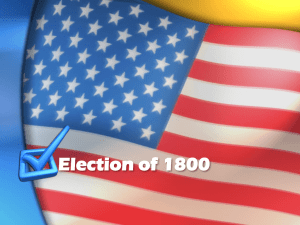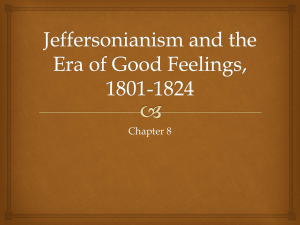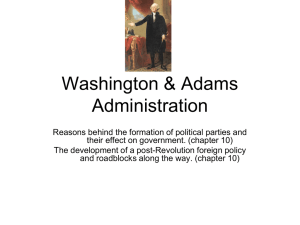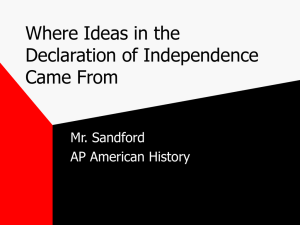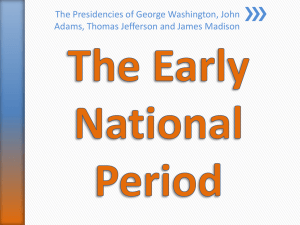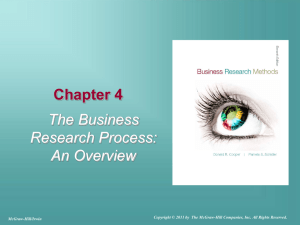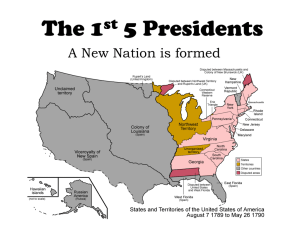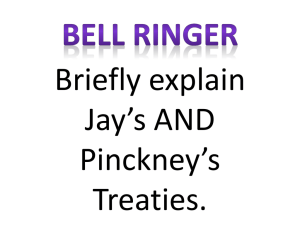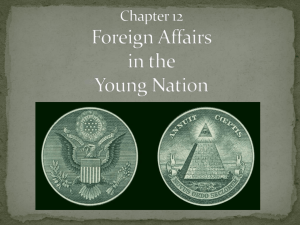Foreign Policy ppt
advertisement
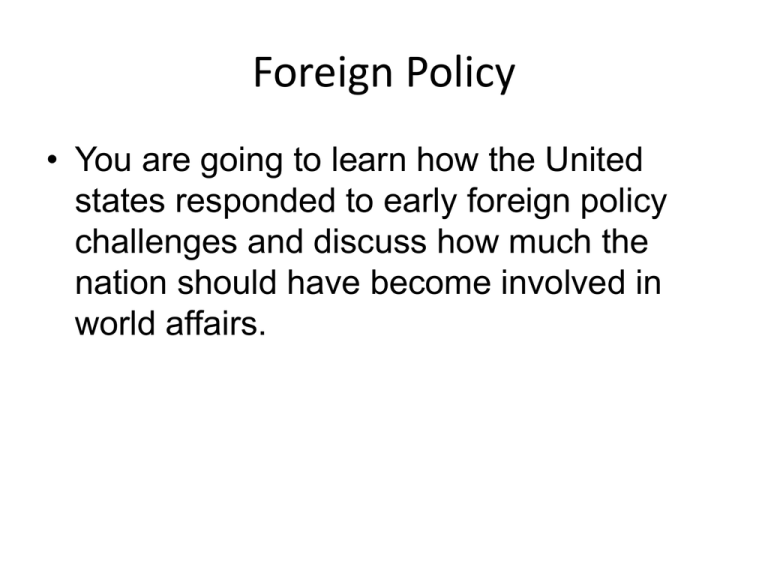
Foreign Policy • You are going to learn how the United states responded to early foreign policy challenges and discuss how much the nation should have become involved in world affairs. U.S. Foreign Policy • Definition: A country’s actions, words, beliefs toward/about other countries • Goals: • 1.) Protect U.S and Americans • 2.) support economic growth and human rights • 3.)increase support of values like democracy and freedom Key players • President and Executive Branch begin policy • Legislative (Congress) carries out the policies. Treaties • Def: Formal agreement between countries • Who? – President –negotiates and signs • Senate approves with a 2/3 vote • Example: Alliance between two countries to protect one another Pg. 225 • Read Section 1. Based on what you just read, propose some possible answers to the Essential Question – • To what extent should the United states have become involved in world affairs in the early 1800’s? President Washington Creates A Foreign Policy Unfriendly neighbors the country Foreign Threats in 1789 The British refused to leave the Ohio Valley The U.S. was still allied with France, which was at war with Great Britain George Washington has just given his farewell address. • Complete the statement to explain the foreign policy he thinks the United States should pursue. I have declared a policy of neutrality and isolationism. This means We will stay out of the affairs of other nations and avoid forming alliances Dilemma 1 • In this activity, you will play the role of foreign policy advisors to four U.S. presidents. • You will be summoned to the White House to make recommendations on how to respond to four foreign policy dilemmas faced by the United states. John Adams Thomas Jefferson • Before you can make your recommendations, you’ll have to do some background reading. James Madison James Monroe Read Section 3, President Adams’s Dilemma: Protecting U.S. Ships • What did the Jay Treaty Resolve? The British agreed to pull their troops from the Ohio Valley. • How did the French respond to the treaty? The French viewed the Jay Treaty as a violation of its own treaty with the United States and began to attack U.S. ships How did Congress react to the XYZ affair? Congress recruited an Army, built new ships for the Navy and authorized war ships and privateers to launch a half war on the seas. Step 4 & 5 For each dilemma, your group will: 1. Discuss all of your options. 2. Prepare arguments in support of one option and in opposition to the other options. 3. Choose a spokesperson to present your group’s recommendations to the President. President Adams’ Foreign Policy Dilemma What should President Adams do to protect U.S. Ships? Option A – Declare war on France immediately Option B – Form a military alliance with Great Britain and declare war on France together Option C – Do not go to war but try to negotiate with France Option D – End all overseas shipping Dilemma 1 • You will now meet with President Adams to advise him on how to respond to this foreign policy dilemma. Esteemed Advisors, thank you for meeting with me. I am interested in your recommendations about how I should respond to this foreign policy dilemma. We will discuss each option. • Each spokesperson who supports Option A, please stand. • Each spokesperson who supports Option B, please stand. • Each spokesperson who supports Option C, please stand. • Each spokesperson who supports Option D, please stand. Thank you advisors, I will take your recommendations into account as I make my decision. Now read section 4, WHAT HAPPENED • Adams Pursues Peace in the Student Text on page 229. Complete the Reading Notes for this section in your packet. • Describe what President Adams did to protect U.S. ships in the Atlantic Ocean. Then explain whether you think he pursued the best foreign policy option. President Adams sent a peace mission to France. French Leader Napoleon had already ended seizing American ships. U.S. made a treaty with France to end 1778 treaty in exchange for U.S. paying cost of ships seized by France. Dilemma • Mark an X along the spectrum to indicate where President Adam’s response to attacks on U.S. ships falls. • Dilemma 2 • To prepare for the next round, read Section 5, President Jefferson’s Dilemma: Dealing with Pirates • Complete the Reading Notes for the section in your Interactive Student 1. Why did Great Britain impress U.S. sailors in the early 1800’s. Great Britain impressed U.S. sailors to serve in the British Navy. They claimed the men were British deserters. • Create a simple drawing to represent the problem of piracy by the Barbary States of North Africa. Then explain President Jefferson’s dilemma. Jefferson had to decide whether to pay tribute to the ruler of Tripoli or go to war with the Barbary States. President Jefferson’s Foreign Policy Dilemma How should President Jefferson deal with piracy in the Mediterranean Sea? Option A: Pay the increased tribute to the Tripoli ruler and avoid war. Option B: Send a peace envoy to Tripoli to negotiate Option C: Send warships to the Mediterranean Sea to protect U.S. shipping interests. Option D: End all U.S. shipping in the Mediterranean Sea. How did Jefferson respond to piracy in the Mediterranean Sea? • Jefferson sent a small fleet of warships to protect American ships. America bombarded Tripoli with cannons. • A peace treaty was signed that ended Tripoli asking for tribute in return for U.S. paying 60,000 in ransom for kidnapped crew members. • Mark an X along the spectrum to indicate where President Jefferson’s response to piracy in the Mediterranean falls, Mark an O to indicate whether his response to seizures of U.S. ships by Great Britain and France reflected more isolationism or more involvement. Tombstones • • • • • Criteria for Each President Name of President Dates of Presidency Explain presidential Dilemma What was the President’s decision? Do you agree or disagree? Why or why not? • Symbol that represents the Foreign Policy choice. Tombstones? Thomas Jefferson’s tombstone • Here was buried Thomas Jefferson, Author of the Declaration of American Independence…Father of the University of Virginia Jefferson Davis’ tombstone • At rest • an American soldier • who defended the Constitution Benjamin Franklin’s tombstone • The Body of B. Franklin, printer Like the Cover of an old Book Its Contents torn out And stripped of its Lettering & guilding Lies here food for worms For, it will as he believed appear once more In a new and more elegant edition Corrected and improved by the Author." Mel Blanc’s tombstone • “That’s all, folks!” Dilemma 3 • To prepare for this situation, read section 12:7 (pg. 232)—President Madison’s Dilemma: Protecting Sailors and Settlers • Complete the graphic organizer for section 7 about our reasons for going to war in 1812 Impressment of sailors Reasons for going to war in 1812 National pride Making the frontier safe for settlement President Madison’s Foreign Policy Dilemma Video: The War of 1812 Dilemma 3: Resolution • Now read section 12.8—What Happened: The War of 1812 War of 1812: Timeline 1812 July 1812: Congress declares war on Great Britain 1813 1814 September 1813: U.S. Naval force captures a British fleet on Lake Erie August 1814: British army invades Washington, DC 1815 December 1814: U.S. and British diplomats sign peace treaty in Belgium January 1815: Battle of New Orleans Dilemma 3: Spectrum • Mark an X along the spectrum to indicate where President Madison’s decision to declare war on Great Britain falls. Make sure you write a sentence justifying your placement. Dilemma 4: President Monroe • To prepare for this situation, read section 12.9 (page 235)—President Monroe’s Dilemma: A New Foreign Policy Challenge • Why might the U.S. have been interested in supporting new Latin America nations in the early 1800s? – We were genuinely concerned for the well-being of the new nations Processing Activity: Foreign Policy Legacies Events in Early American Foreign Policy • Washington: Establishes neutrality and isolationism • Adams: Pursues peace • Jefferson: Some military protection for ships, but stayed isolated with Embargo Act • Madison: Abandons isolationism and declares War of 1812

